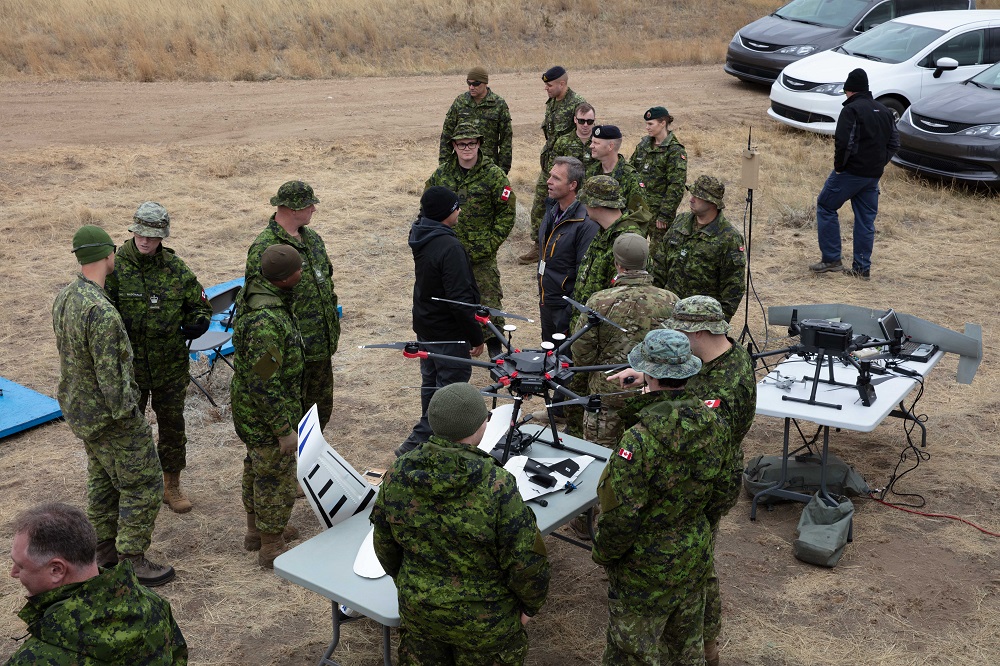Australian defence and space company Electro Optic Systems Australia has made a strong showing at the Counter Uncrewed Aerial Systems Sandbox.
To continue reading the rest of this article, please log in.
Create free account to get unlimited news articles and more!
Defence companies from across the globe were invited to compete with their best drone-destroying technology in real-world environment scenarios at the sandbox event held in Alberta, Canada from 12 September to 7 October last year.
Teams were given the objective of detecting or defeating (kinetically or non-kinetically) micro and mini uncrewed aerial systems with systems that can be integrated into the broader military command and control system.

PHOTO: Members of the Canadian Armed Forces and civilians observing drones from the Red Team.
The operational scenarios included defending a forward operating base, airfield, or VIP conference location; defending a mobile vehicle patrol of five vehicles; defending 12 dismounted soldiers or a VIP group in a static location; defending major city downtown location square of four city blocks; and defending a ship’s superstructure docked or underway in coastal water.
Each scenario was evaluated on the ability to detect and track the UAS before the UAS detects, observes, acts or transmits any data it collects. Teams were also evaluated on the ability to recognise the UAS as a mini/micro UAS, larger UAS or an aircraft to reduce the likelihood of accidental alarms.
EOS executive vice president Matt Jones said the company was able to send their R400S remote weapon station — mounted with a 7.62mm M240B machine gun — from Australia to Canada and collect critical data about the counter-UAV performance.
“They (sandbox organisers) offered VIP attendance to NATO and North America affiliated countries to observe the performance of systems that they were evaluating or demonstrating,” he said.
“Our participation not only allowed us to get third-party verification of our achievement at various ranges and targets using our technology, but we could also demonstrate that to NATO-affiliated countries.
“We have an interim series of results (from our hard kill lethality). We were constrained to engage drones with machine gun on remote weapons system. We achieved static and moving engagements at 300 metres, 500 metres, 800 metres against targets that are less than 30 centimetres or 10 centimetres high.
“It showcased, even with a standard weapon system, we could engage successfully and destroy small commercial drones and potentially higher-end drones with relatively cheap, standard ammunition.
“You don’t need specialised weapons or specialist ammunition to defeat these types of low-end threats, and that’s one of the strengths of our system.
“We can fill the gap with lower end and much cheaper supplies against the volume of low-end threats. We can kill a maverick or low-end group one drone for about $5 or $10 with ammunition you already have and a weapon you already have.”
Other teams taking part included AerialX, CACI Inc, Drone Shield, Echodyne Corp, Edgesource Corporation, Hensoldt Sensors GmbH, LiveLink Aerospace Ltd, MyDefence A/S, SkySafe, Teledyne FLIR Unmanned Aerial Systems, and Thales Canada Inc.
Subject matter experts and end users of the event included Canadian Joint Operations Command, Canadian Army, Royal Canadian Navy, Royal Canadian Air Force, Canadian Special Operations Forces Command, Defence Research and Development Canada, Royal Canadian Mounted Police, and the US Department of Defense Irregular Warfare Technical Support Directorate.
The event is hosted annually by the Innovation for Defence Excellence and Security (IDEaS), an innovation and investment program sponsored by the Canadian government.

 Login
Login







